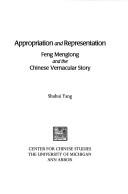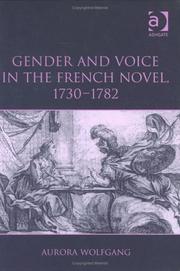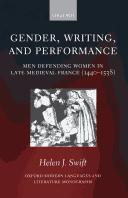| Listing 1 - 10 of 363 | << page >> |
Sort by
|
Book
ISBN: 1496216105 1496216083 1496215958 9781496216106 9781496215956 9781496216083 9781496216090 Year: 2019 Publisher: Lincoln
Abstract | Keywords | Export | Availability | Bookmark
 Loading...
Loading...Choose an application
- Reference Manager
- EndNote
- RefWorks (Direct export to RefWorks)
Women in literature. --- Woman (Christian theology) in literature --- Women in drama --- Women in poetry --- Sandoz, Mari, --- Criticism and interpretation.
Book
ISBN: 161249028X 161249899X 1557534918 Year: 2008 Publisher: West Lafayette, Ind. : Purdue University Press,
Abstract | Keywords | Export | Availability | Bookmark
 Loading...
Loading...Choose an application
- Reference Manager
- EndNote
- RefWorks (Direct export to RefWorks)
Witches in literature. --- Women in literature. --- Feminist criticism. --- Criticism --- Woman (Christian theology) in literature --- Women in drama --- Women in poetry
Book
ISBN: 0190252812 1283232189 9786613232182 0199781052 0195398041 0199338566 9780199781058 9780195398045 9780190252816 9781283232180 6613232181 Year: 2011 Publisher: Oxford ; New York : Oxford University Press,
Abstract | Keywords | Export | Availability | Bookmark
 Loading...
Loading...Choose an application
- Reference Manager
- EndNote
- RefWorks (Direct export to RefWorks)
Domestic handicraft was an extraordinarily popular leisure activity in Victorian Britain, especially amongst middle-class women. Craftswomen pasted shells onto boxes, stitched fish scales onto silk, scorched patterns into wood, cast flower petals out of wax, and made needlework portraits of the royal spaniels. Yet despite its ubiquity, little has been written about this curious hobby. Providing a much-needed history of this under-studied phenomenon, Talia Schaffer demonstrates the importance of domestic handicraft in Victorian literature and culture. Novel Craft presents what Schaffer terms.
English fiction --- Women in literature. --- Domestic fiction, English --- Women and literature --- History and criticism. --- History --- Woman (Christian theology) in literature --- Women in drama --- Women in poetry
Book
ISBN: 3030304760 3030304752 Year: 2019 Publisher: Cham : Springer International Publishing : Imprint: Palgrave Macmillan,
Abstract | Keywords | Export | Availability | Bookmark
 Loading...
Loading...Choose an application
- Reference Manager
- EndNote
- RefWorks (Direct export to RefWorks)
This book views late Victorian femininity, the New Woman, and gender through literary representations of the figure of the monster, an appendage to the New Woman. The monster, an aberrant occurrence, performs Brecht’s “alienation effect,” making strange the world that she inhabits, thereby drawing veiled conclusions about the New Woman and gender at the end of the fin-de-siècle. The monster reveals that New Women loved one another complexly, not just as “friend” or “lover,” but both “friend” and “lover.” The monster, like the fin-de-siècle British populace, mocked the New Woman’s modernity. She was paradoxically viewed as a threat to society and as a role model for women to follow. The tragic suicides of “monstrous” New Women of color suggest that many fin-de-siècle authors, especially female authors, thought that these women should be included in society, not banished to its limits. This book, the first on the relationship between the figure of the monster and the New Woman, argues that there is hidden complexity to the New Woman. Her sexuality was complicated and could move between categories of sexuality and friendship for late Victorian women, and the way that the fin-de-siècle populace viewed her was just as multifarious. Further, the narratives of her tragedies ironically became narratives that advocated for her survival. Elizabeth D. Macaluso teaches and tutors writing at Queensborough Community College, USA. She previously taught Victorian and British fin-de-siècle literatures and topics in rhetoric and composition at Binghamton University, USA. This is her first critical book on the late Victorian period. Macaluso is also a published poet, with poetry featured in VIA, Arba Sicula, The Paterson Literary Review, and the San Diego Poetry Annual. Her first volume of poetry, The Lighthouse, will be published by Guernica Editions. Macaluso has earned The Dr. Alfred Bendixen Award for Distinguished Teaching by a Graduate Student in English and the Graduate Student Excellence Award in Teaching for her work with Binghamton University undergraduates. She has attended numerous conferences on her critical and creative work.

ISBN: 0892641258 0472901516 Year: 1998 Publisher: Ann Arbor : Center for Chinese Studies, University of Michigan,
Abstract | Keywords | Export | Availability | Bookmark
 Loading...
Loading...Choose an application
- Reference Manager
- EndNote
- RefWorks (Direct export to RefWorks)

ISBN: 9780754637028 0754637026 9781351934732 1351934732 9781351934725 1351934724 1138378801 1315254662 9781315254661 9781351934718 Year: 2016 Publisher: Milton Park, Abingdon, Oxon New York, NY
Abstract | Keywords | Export | Availability | Bookmark
 Loading...
Loading...Choose an application
- Reference Manager
- EndNote
- RefWorks (Direct export to RefWorks)
Analyzing four best-selling novels - by both women and men - written in the feminine voice, this book traces how the creation of women-centered salons and the emergence of a feminine poetic style engendered a new type of literature in eighteenth-century France. The author argues that writing in a female voice allowed writers of both sexes to break with classical notions of literature and style, so that they could create a modern sensibility that appealed to a larger reading public, and gave them scope to innovate with style and form. Wolfgang brings to light how the 'female voice' in literature came to embody the language of sociability, but also allowed writers to explore the domain of inter-subjectivity, while creating new bonds between writers and the reading public. Through examination of Marivaux's La Vie de Marianne, Graffigny's Lettres d'une Péruvienne, Riccoboni's Lettres de Mistriss Fanni Butlerd, and Laclos's Les Liaisons dangereuses, she shows that in France, this modern 'feminine' sensibility turned the least prestigious of literary genres - the novel - into the most compelling and innovative literary form of the eighteenth century. Emphasizing how the narratives analyzed here refashioned the French literary world through their linguistic innovation and expression of new forms of subjectivity, this study claims an important role for feminine-voice narratives in shaping the field of eighteenth-century literature.
French fiction --- Gender identity in literature. --- Women in literature. --- History and criticism. --- Woman (Christian theology) in literature --- Women in drama --- Women in poetry

ISBN: 1281770035 9786611770037 0191552518 9780191552519 6611770038 0199232237 9780199232239 1383036616 9781281770035 Year: 2008 Publisher: Oxford : New York : Clarendon Press ; Oxford University Press,
Abstract | Keywords | Export | Availability | Bookmark
 Loading...
Loading...Choose an application
- Reference Manager
- EndNote
- RefWorks (Direct export to RefWorks)
Helen Swift examines late-medieval and early-modern French imaginative literature written by men in defence of women of great popularity in its own time - including catalogues of virtuous women, allegorical narratives, and debate poems.
French literature --- Women in literature. --- Woman (Christian theology) in literature --- Women in drama --- Women in poetry --- History and criticism. --- Male authors
Book
ISBN: 1282622870 9786612622878 0299234932 9780299234935 0299234940 9780299234942 9780299234942 9781282622876 6612622873 Year: 2010 Publisher: Madison, Wis. University of Wisconsin Press
Abstract | Keywords | Export | Availability | Bookmark
 Loading...
Loading...Choose an application
- Reference Manager
- EndNote
- RefWorks (Direct export to RefWorks)
Female genital excision, or the ritual of cutting the external genitals of girls and women, is undoubtedly one of the most heavily and widely debated cultural traditions of our time. By looking at how writers of African descent have presented the practice in their literary work, Elisabeth Bekers shows how the debate on female genital excision evolved over the last four decades of the twentieth century, in response to changing attitudes about ethnicity, nationalism, colonialism, feminism, and human rights. Rising Anthills (the title refers to a Dogon myth) analyzes works in English, French, and Arabic by African and African American writers, both women and men, from different parts of the African continent and the diaspora. Attending closely to the nuances of language and the complexities of the issue, Bekers explores lesser-known writers side by side with such recognizable names as Ngugi wa Thiong'o, Flora Nwapa, Nawal El Saadawi, Ahmadou Kourouma, Calixthe Beyala, Alice Walker, and Gloria Naylor. Following their literary discussions of female genital excision, she discerns a gradual evolution--from the 1960s, when writers mindful of its communal significance carefully "wrote around" the physical operation, through the 1970s and 1980s, when they began to speak out against the practice and their societies' gender politics, to the late 1990s, when they situated their denunciations of female genital excision in a much broader, international context of women's oppression and the struggle for women's rights.
Book
ISBN: 0804772959 9780804772952 9780804761970 0804761973 9780804761987 0804761981 Year: 2010 Publisher: Stanford, Calif. Stanford University Press
Abstract | Keywords | Export | Availability | Bookmark
 Loading...
Loading...Choose an application
- Reference Manager
- EndNote
- RefWorks (Direct export to RefWorks)
Presenting a fresh examination of women writers and prewar ideology, this book breaks new ground in its investigation of love as a critical aspect of Japanese culture during the early to mid-twentieth century. As a literary and cultural history of love and female identity, Becoming Modern Women focuses on same-sex love, love marriage, and maternal love—new terms at that time; in doing so, it shows how the idea of "woman," within the context of a vibrant print culture, was constructed through the modern experience of love. Author Michiko Suzuki's work complements current scholarship on female identities such as "Modern Girl" and "New Woman," and interprets women's fiction in conjunction with nonfiction from a range of media—early feminist writing, sexology books, newspapers, bestselling love treatises, native ethnology, and historiography. While illuminating the ways in which women used and challenged ideas about love, Suzuki explores the historical and ideological shifts of the period, underscoring the broader connections between gender, modernity, and nationhood.
Japanese fiction --- Women in literature. --- Love in literature. --- Woman (Christian theology) in literature --- Women in drama --- Women in poetry --- Japanese literature --- Women authors --- History and criticism.
Book
ISBN: 081306421X 081304619X 081304507X 9780813045078 9780813044187 0813044189 1299818773 0813063973 Year: 2013 Publisher: Gainesville
Abstract | Keywords | Export | Availability | Bookmark
 Loading...
Loading...Choose an application
- Reference Manager
- EndNote
- RefWorks (Direct export to RefWorks)
An analysis of medieval literature through an exploration of the female gaze.
Gaze in literature. --- Women in literature. --- Voyeurism in literature. --- German literature --- Woman (Christian theology) in literature --- Women in drama --- Women in poetry --- History and criticism.
| Listing 1 - 10 of 363 | << page >> |
Sort by
|

 Search
Search Feedback
Feedback About UniCat
About UniCat  Help
Help News
News